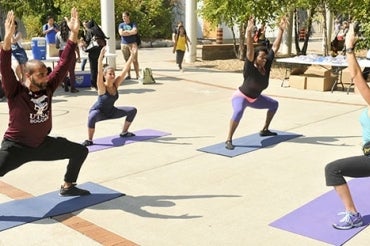
Photo of an athletics barbeque at U of T Scarborough by Ken Jones
Published: January 22, 2018
By
 Robin Waley wants to make it easy to practice yoga and mindfulness every day. “Yoga isn’t just physical postures on a mat in a gym - it’s is a path to living healthy and happily”, says Waley. “Yoga is comprised of both mindfulness and movement practices which are easy to maintain throughout your day at work.” The yoga instructor and assistant manager of aquatics at the Faculty of Kinesiology and Physical Education, shares five easy tips that could help you lower stress and gain energy.
Robin Waley wants to make it easy to practice yoga and mindfulness every day. “Yoga isn’t just physical postures on a mat in a gym - it’s is a path to living healthy and happily”, says Waley. “Yoga is comprised of both mindfulness and movement practices which are easy to maintain throughout your day at work.” The yoga instructor and assistant manager of aquatics at the Faculty of Kinesiology and Physical Education, shares five easy tips that could help you lower stress and gain energy.
1) Make the time, start small
We all live busy lives and work is no exception. You need to make a commitment to develop a regular practice in anything, including yoga. I recommend starting with small shifts and changes to your normal routine and see how they feel.
2) Get outside
We often get stuck sitting at our desks making up excuses why we can’t leave for a break. Turn a walk in the outdoors to a movement meditation: breathe deeply, take each step mindfully, and focus on experiencing the present moment.
3) Posture! Posture! Posture!
Studies have shown that good posture helps you maintain energy and avoid fatigue, but most importantly lowers stress levels. Try to sit up tall throughout the day using deep belly expanding breaths to support your seat. Inhale and rise up through the crown of your head, exhale and root down through your seat. Repeat this cycle a few times and it will assist in lengthening your spine whenever you feel the slouch taking over.
4) Pause, breathe deep and relax
Focusing on your breath relaxes your mind, brings oxygen to your brain, calms physical tension, and soothes your heart rate and nervous system. Any time you feel high levels of stress, anxiety, or frustration at work (and even when you don’t) I recommend pausing, closing your eyes and inhaling for four seconds, then exhaling: four, three, two, and one. Repeat this cycle focusing your attention on your breath, and tuning into any subtle changes or shifts within you mentally, physically or emotionally. Repeat 10 rounds, or continue until you feel calm.
5) Stretch in your seat!
Sitting doesn’t have to be sedentary. You can stretch in your seat to help keep your muscles moving. Try:
a) Seated pigeon - bring your ankle to your opposite knee, flex your foot and breath into your hip for 5 deep breaths. Repeat on the other side.
b) Seated twist – reach across your body to your opposite arm rest or base of your chair. Grip the back of your chair with your other hand and begin to twist. Breathe into your deepest twist and hold for 5 breaths then switch sides.
c) Crescent moon – inhale your arms over your head bringing your hands together, exhale and tilt to the right. Hold for five deep breaths, breathing into the left side of your body. Repeat on the other side.
d) Seated forward fold – fold slowly over your legs towards your toes on a long exhale relaxing your head and neck at the end. Next, roll yourself up one vertebrae at a time on a long inhale allowing your head and neck to be the last to stack. Repeat three times.

Photos of Robin Waley courtesy of Robin Waley.
